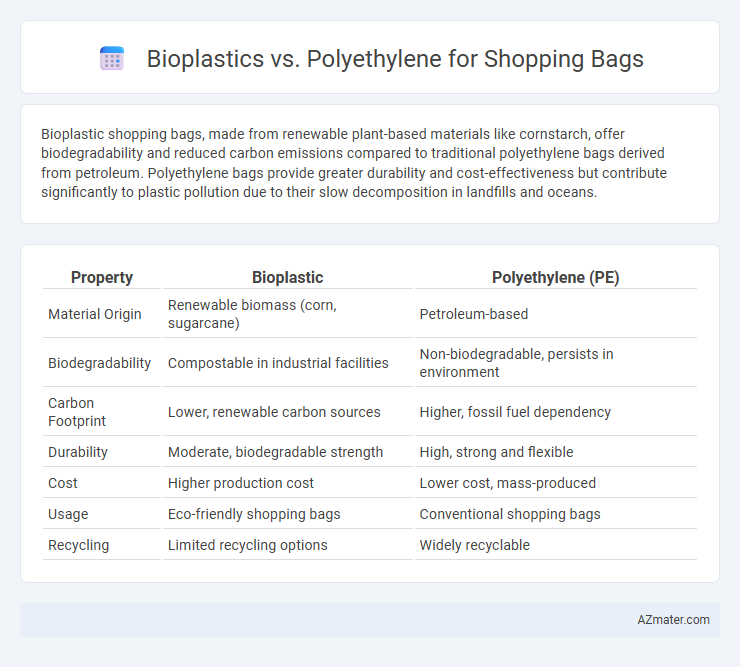Bioplastic shopping bags, made from renewable plant-based materials like cornstarch, offer biodegradability and reduced carbon emissions compared to traditional polyethylene bags derived from petroleum. Polyethylene bags provide greater durability and cost-effectiveness but contribute significantly to plastic pollution due to their slow decomposition in landfills and oceans.
Table of Comparison
| Property | Bioplastic | Polyethylene (PE) |
|---|---|---|
| Material Origin | Renewable biomass (corn, sugarcane) | Petroleum-based |
| Biodegradability | Compostable in industrial facilities | Non-biodegradable, persists in environment |
| Carbon Footprint | Lower, renewable carbon sources | Higher, fossil fuel dependency |
| Durability | Moderate, biodegradable strength | High, strong and flexible |
| Cost | Higher production cost | Lower cost, mass-produced |
| Usage | Eco-friendly shopping bags | Conventional shopping bags |
| Recycling | Limited recycling options | Widely recyclable |
Introduction to Shopping Bag Materials
Shopping bag materials predominantly include bioplastics and polyethylene, each offering distinct environmental and functional characteristics. Bioplastics are derived from renewable biomass sources like corn starch or sugarcane, making them biodegradable and compostable under specific conditions. Polyethylene, a petroleum-based polymer, is widely used for its durability and cost-effectiveness but poses significant environmental challenges due to its non-biodegradable nature and contribution to plastic pollution.
What is Bioplastic?
Bioplastic is a type of biodegradable material derived from renewable biomass sources such as corn starch, sugarcane, or vegetable fats, offering an eco-friendly alternative to conventional petroleum-based plastics like polyethylene. It breaks down more easily in the environment, reducing plastic pollution and landfill accumulation compared to non-biodegradable polyethylene shopping bags. The key advantage of bioplastic lies in its ability to maintain similar physical properties to polyethylene while significantly lowering carbon footprint and promoting sustainable waste management.
Understanding Polyethylene
Polyethylene, a widely used thermoplastic polymer, dominates the shopping bag market due to its durability, flexibility, and low production cost. Its molecular structure, consisting of long chains of ethylene monomers, provides high tensile strength and resistance to moisture, making it ideal for carrying various goods. However, polyethylene's resistance to biodegradation results in persistent environmental pollution, contrasting with the compostable nature of bioplastics designed to reduce plastic waste.
Environmental Impact: Bioplastic vs Polyethylene
Bioplastic shopping bags, derived from renewable biomass sources like corn starch or sugarcane, generally offer a lower carbon footprint compared to polyethylene bags made from non-renewable petroleum. Bioplastics are often biodegradable or compostable under industrial conditions, reducing long-term pollution and landfill accumulation, whereas polyethylene persists in the environment for hundreds of years, contributing to microplastic pollution. However, the environmental impact of bioplastic depends on waste management infrastructure and agricultural inputs, while polyethylene recycling rates remain low, exacerbating plastic pollution challenges.
Production Process Comparison
Bioplastic shopping bags are produced through the polymerization of renewable resources such as cornstarch or sugarcane, resulting in a biodegradable and compostable material with a lower carbon footprint. Polyethylene bags are synthesized from petrochemical processes, involving the polymerization of ethylene derived from natural gas or crude oil, leading to durable but non-biodegradable plastic. The bioplastic production process emphasizes renewable feedstocks and enzymatic degradation, whereas polyethylene relies on fossil fuels and generates persistent plastic waste.
Durability and Performance
Bioplastic shopping bags, typically made from renewable resources like cornstarch, exhibit moderate durability but may degrade faster under heavy use compared to polyethylene bags. Polyethylene bags, derived from fossil fuels, offer superior tensile strength and resistance to tearing, ensuring better performance for carrying heavier items and repeated use. While bioplastics provide environmental benefits through biodegradability, polyethylene remains the industry standard due to its proven durability and reliable load-bearing capacity in shopping applications.
Cost Analysis of Bioplastic vs Polyethylene Bags
Bioplastic shopping bags typically have higher production costs compared to polyethylene bags due to expensive raw materials like corn starch or sugarcane derivatives and less mature manufacturing processes. Polyethylene bags benefit from lower costs and economies of scale, making them more affordable for large-scale retail use. Over time, price fluctuations in bioplastic feedstocks and advancements in technology could narrow the cost gap between these two materials.
Biodegradability and End-of-Life Options
Bioplastic shopping bags degrade more rapidly under industrial composting conditions, breaking down into natural elements within months compared to polyethylene, which can persist for centuries in landfills. Bioplastics offer multiple end-of-life options, including composting and anaerobic digestion, that reduce environmental impact, whereas polyethylene primarily relies on recycling or accumulation in waste streams. The enhanced biodegradability of bioplastics addresses plastic pollution concerns, but practical disposal depends heavily on local waste management infrastructure.
Consumer Perception and Market Trends
Consumer perception favors bioplastic shopping bags due to their eco-friendly appeal and biodegradability, aligning with increasing environmental awareness. Market trends reveal a growing demand for bioplastics, driven by stricter regulations on single-use polyethylene bags and a shift towards sustainable alternatives. However, polyethylene remains dominant in affordability and durability, maintaining a significant market share despite sustainability concerns.
Future Outlook for Shopping Bag Materials
Bioplastic shopping bags, derived from renewable resources like cornstarch or sugarcane, are gaining traction due to their biodegradability and reduced carbon footprint compared to traditional polyethylene bags made from fossil fuels. Innovations in bioplastic formulations aim to improve strength, durability, and cost-effectiveness, potentially overcoming current performance limitations and enhancing consumer acceptance. Market trends indicate a significant shift towards sustainable materials, driven by increasing regulatory restrictions on single-use plastics and growing environmental awareness, positioning bioplastics as a promising future alternative for shopping bag production.

Infographic: Bioplastic vs Polyethylene for Shopping bag
 azmater.com
azmater.com